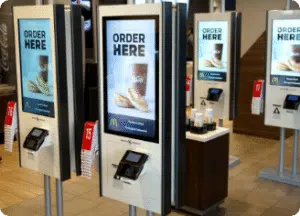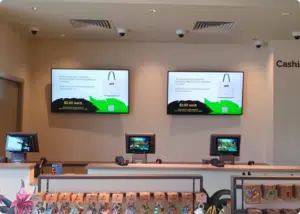Why Real-Time Content Matters
The key advantage of real-time updates lies in relevance. Traditional static content quickly becomes outdated and may not resonate with viewers. Real-time content, on the other hand, ensures that what’s being displayed is current, accurate, and tailored to the moment. This can include anything from:
-
Live news feeds and weather updates
-
Social media streams
-
Inventory and pricing changes
-
Emergency alerts
-
Event schedules and announcements
By providing timely information, businesses can significantly enhance audience engagement and customer satisfaction.
Industries Benefiting from Real-Time Digital Signage
Retail: Showcasing flash sales, new arrivals, and live inventory status to drive purchases.
Transportation: Updating arrival/departure times, gate changes, or traffic conditions for smooth passenger flow.
Hospitality: Welcoming guests with personalized messages, or updating conference room schedules on the fly.
Corporate: Sharing live performance metrics, internal news, or meeting reminders across office displays.
Healthcare: Displaying wait times, queue numbers, or health tips in waiting areas.
How It Works: The Role of CMS
A Content Management System (CMS) is the backbone of real-time digital signage. A robust CMS allows for centralized control, remote content deployment, and automated scheduling. Advanced systems integrate with APIs or data feeds to pull in live information, enabling a seamless and dynamic experience for viewers.
Boosting Engagement Through Dynamic Displays
Real-time updates enhance digital signage effectiveness by keeping content fresh and eye-catching. This dynamic approach prevents screen fatigue and encourages viewers to regularly check displays for new information. In turn, businesses gain more traction and better ROI from their signage investments.
Future Trends in Real-Time Digital Signage
Looking ahead, the integration of AI and IoT is set to push real-time signage even further. Imagine displays that adapt to the weather, traffic conditions, or customer behavior—without manual input. Personalization and automation will play a crucial role in the next wave of digital transformation.
Conclusion
Real-time content updates in digital signage are no longer just a trend—they’re a necessity. By embracing this technology, businesses can deliver more impactful messaging, adapt to audience needs instantly, and stay competitive in a connected world.
Whether you’re in retail, healthcare, hospitality, or any other industry, now is the time to make your digital signage strategy more dynamic, data-driven, and real-time.

















